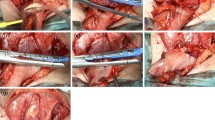Abstract
Purpose
To evaluate the safety and feasibility of the triangulating stapling technique (TST) for cervical esophagogastric anastomosis after esophagectomy (CEGA).
Methods
The subjects were 123 patients who underwent transthoracic esophagectomy with three-field lymph node dissection and reconstruction with a 3.5-cm wide gastric tube, for thoracic esophageal cancer. We performed the TST for CEGA in 33 patients operated on after December, 2006 (TST group) and hand-sewn anastomosis in 90 patients operated on between 2002 and 2006 (HSA group).
Results
In the TST group, CEGA was performed in an end-to-end fashion using three linear staplers. The first anastomosis was applied to the posterior walls of the remnant esophagus and gastric tube in an inverted fashion. The second and the third anastomoses were done in an everted fashion to make the anterior wall. The end-to-end HSA was performed with interrupted sutures using 4-0 absorbable material. Anastomotic leakage occurred in only 1 (3.0%) of the 33 TST patients, but in 13 (14.4%) of the 90 HSA patients (P = 0.07). The frequency of anastomotic stenosis was 9.1% and 25.6% in the TST and HSA groups, respectively (P < 0.05).
Conclusions
Cervical esophagogastric anastomosis using TST may reduce the frequency of anastomotic leakage and stenosis. This technique is a safe and reliable alternative for CEGA after esophagectomy.
Similar content being viewed by others
References
Muller JM, Erasmi H, Stelzner M, Zieren U, Pichlmaier H. Surgical therapy of oesophageal carcinoma. Br J Surg 1990;77:845–857.
Urschel JD. Esophagogastrostomy anastomotic leaks complicating esophagectomy: a review. Am J Surg 1995;169:634–640.
Alanezi K, Urschel JD. Mortality secondary to esophageal anastomotic leak. Ann Thorac Cardiovasc Surg 2004;10:71–75.
Ercan S, Rice TW, Murthy SC, Rybicki LA, Blackstone EH. Does esophagogastric anastomotic technique influence the outcome of patients with esophageal cancer? J Thorac Cardiovasc Surg 2005;129:623–631.
Mitchell JD. Anastomotic leak after esophagectomy. Thorac Surg Clin 2006;16:1–9.
Hsu HH, Chen JS, Huang PM, Lee JM, Lee YC. Comparison of manual and mechanical cervical esophagogastric anastomosis after esophageal resection for squamous cell carcinoma: a prospective randomized controlled trial. Eur J Cardiothorac Surg 2004;25:1097–1101.
Korst RJ, Port JL, Lee PC, Altorki NK. Intrathoracic manifestations of cervical anastomotic leaks after transthoracic esophagectomy for carcinoma. Ann Thorac Surg 2005;80:1185–1190.
Santos RS, Raftopoulos Y, Singh D, DeHoyos A, Fernando HC, Keenan RJ, et al. Utility of total mechanical stapled cervical esophagogastric anastomosis after esophagectomy: a comparison to conventional anastomotic techniques. Surgery 2004;136: 917–925.
Wong J, Cheung H, Lui R, Fan YW, Smith A, Siu KF. Esophagogastric anastomosis performed with a stapler: the occurrence of leakage and stricture. Surgery 1987;101:408–415.
Orringer MB, Marshall B, Iannettoni MD. Eliminating the cervical esophagogastric anastomotic leak with a side-to-side stapled anastomosis. J Thorac Cardiovasc Surg 2000;119:277–288.
Venkatesh KS, Morrison N, Larson DM, Ramanujam P. Triangulating stapling technique: an alternative approach to colorectal anastomosis. Dis Colon Rectum 1993;36:73–76.
Fukunaga Y, Higashino M, Tanimura S, Osugi H. Triangulating stapling technique for reconstruction after colectomy. Hepatogastroenterology 2007;54:414–417.
Furukawa Y, Hanyu N, Hirai K, Ushigome T, Kawasaki N, Toyama Y, et al. Usefulness of automatic triangular anastomosis for esophageal cancer surgery using a linear stapler (TA-30). Ann Thorac Cardiovasc Surg 2005;11:80–86.
Sugimachi K, Ikeda M, Kai H, et al. Assessment of the blood flow in various gastric tubes for esophageal substitutes. J Surg Res 1982;33:463–468.
Fujita H, Kakegawa T, Yamana H, Shima I, Toh Y, Tomita Y, et al. Mortality and morbidity rates, postoperative course, quality of life, and prognosis after extended radical lymphadenectomy for esophageal cancer. Comparison of three-field lymphadenectomy with two-field lymphadenectomy. Ann Surg 1995;222:654–662.
Zhu ZJ, Zhao YF, Chen LQ, Hu Y, Liu LX, Wang Y, et al. Clinical application of layered anastomosis during esophagogastrostomy. World J Surg 2008;32:583–588.
Lee Y, Fujita H, Yamana H, Kakegawa T. Factors affecting leakage following esophageal anastomosis. Surg Today 1994;24:24–29.
Beitler AL, Urschel JD. Comparison of stapled and hand-sewn esophagogastric anastomoses. Am J Surg 1998;175:337–340.
Okuyama M, Motoyama S, Suzuki H, Saito R, Maruyama K, Ogawa J. Hand-sewn cervical anastomosis versus stapled intrathoracic anastomosis after esophagectomy for middle or lower thoracic esophageal cancer: a prospective randomized controlled study. Surg Today 2007;37:947–952.
Sarela AI, Tolan DJ, Harris K, Dexter SP, Sue-Ling HM. Anastomotic leakage after esophagectomy for cancer: a mortality-free experience. J Am Coll Surg 2008;206:516–523.
Tabira Y, Sakaguchi T, Kuhara H, Teshima K, Tanaka M, Kawasuji M. The width of a gastric tube has no impact on outcome after esophagectomy. Am J Surg 2004;187:417–421.
Law S, Fok M, Chu KM, Wong J. Comparison of hand-sewn and stapled esophagogastric anastomosis after esophageal resection for cancer: a prospective randomized controlled trial. Ann Surg 1997;226:169–173.
The Japanese Esophageal Society. Guide lines for the clinical and pathological studies on carcinoma of the esophagus. 10th ed. Tokyo: Kanehara; 2007.
Author information
Authors and Affiliations
Rights and permissions
About this article
Cite this article
Toh, Y., Sakaguchi, Y., Ikeda, O. et al. The triangulating stapling technique for cervical esophagogastric anastomosis after esophagectomy. Surg Today 39, 201–206 (2009). https://doi.org/10.1007/s00595-008-3827-2
Received:
Accepted:
Published:
Issue Date:
DOI: https://doi.org/10.1007/s00595-008-3827-2




